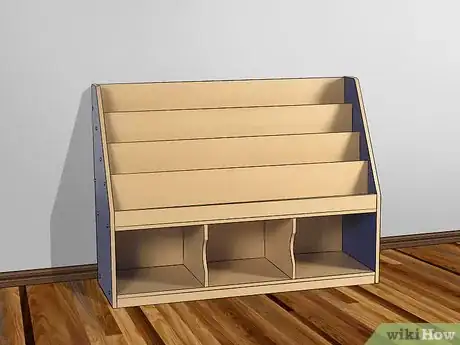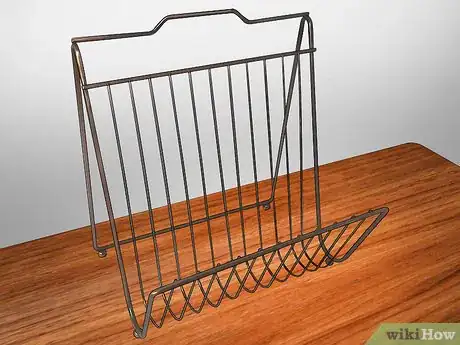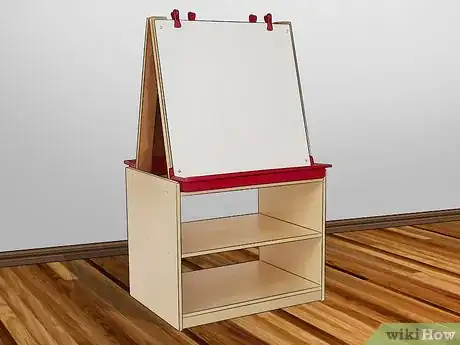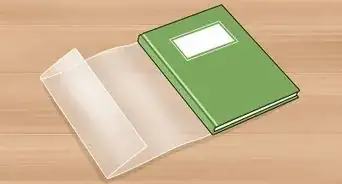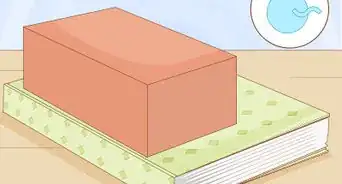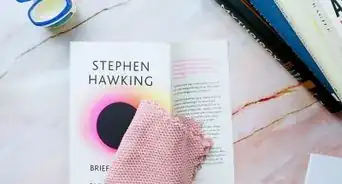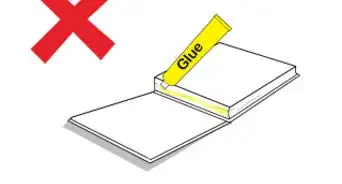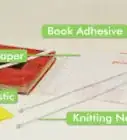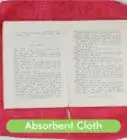This article was co-authored by Ashley Moon, MA. Ashley Moon is the Founder and CEO of Creatively Neat, a virtual organizing and life coaching business based in Los Angeles, California. In addition to helping people organize their best life, she has a fabulous team of organizers ready to de-clutter your home or business. Ashley hosts workshops and speaking engagements at various venues and festivals. She has trained with Coach Approach and Heart Core for organizing and business coaching respectively. She has an MA in Human Development and Social Change from Pacific Oaks College.
There are 7 references cited in this article, which can be found at the bottom of the page.
This article has been viewed 9,269 times.
If you’re a teacher, you know just how hard it can be to find room for all the supplies you use every day, especially items like big books that take up lots of space. Try keeping your oversized reading materials organized in suitably-sized containers, or stacking them up and finding a place for them in an out-of-the-way corner of the room. Teaching your students to put away their books when they’re finished using them can also help you keep your classroom neat and tidy.
Steps
Putting Away Your Big Books
-
1Invest in some plastic bins. Pick up a few sturdy containers that are large enough to hold the biggest of your big books. Spacious organizers, wrapping paper containers, and square laundry hampers can all make excellent places to stash large picture and activity books.[1]
- If possible, narrow down your search to containers that have lids. A lid will keep your books from spilling out everywhere if the bin happens to get knocked over.
- Measure the height and width of your big books before you start shopping around for containers so you’ll have an idea of what size you need.
- Label the containers by genre or put a picture of the type of book that goes in each bin so that you can keep them organized and accessible for the kids.
-
2Convert an old laundry basket into a portable storage solution. Plastic laundry baskets are essentially extra-tall storage bins. This makes them great for keeping together big books that are stacked vertically. An average-sized basket could hold as many as 2-3 dozen big books, depending on their exact dimensions!
- Rectangular baskets will provide a better fit for your books than round ones.
- As an added bonus, the built-in handles on laundry baskets make it easier to tote your collection of big books around with you.
- Try tying a tag to the laundry basket and using that to label the basket's contents.
Advertisement -
3Gather up your big books in a rolling book box. While they’re not the most spacious option, a book can come in handy for gathering up the books your class has out during reading time. Since they’re on wheels, they can be pushed around for faster cleanup. They may also serve as overflow storage as your collection grows.
- Look for boxes with dividers so can sort your books while you pick them up. Label each divider.
-
4Keep your big books in hanging storage bags. Storage bags can make a fun and interesting alternative to traditional containers like bins and shelves. They’re typically made of clear plastic, so you can see what’s inside without having to open them, and can be hung up on any rack or ledge to conserve floor space.[2]
- Divide your big books up by subject or theme and designate a bag for each group to help keep them sensibly organized.
- Consider hanging your storage bags on a rolling garment rack so you can easily move them from place to place.
Displaying Your Big Books
-
1Purchase a big book display stand. Display stands built specifically for big books usually feature a sturdy, one-piece design with staggered shelves that give you a place to store your big books where the covers will be visible. Most stands are big enough to fit 3-4 big books displayed side-by-side, but aren’t so tall that your kids won’t be able to reach the titles on the upper shelves.[3]
- You can usually find big book display stands on sale for $100-150 at stores that carry classroom supplies.
- Display stands are one of the neater storage options you have available, and won’t look as out of place as an old laundry hamper or row of plastic bins.
-
2Hunt for a suitably-sized bookcase. A bookcase with tall shelves can help you keep your big books put away while also holding other miscellaneous learning supplies and materials. Make sure there’s enough space between each shelf to house your books comfortably—it’s not uncommon for large picture books to be over 1 foot (0.30 m) tall![4]
- Keep an eye out for bookcases you think would be the right fit for your big books, or consider having a custom bookshelf to your exact specifications.
- Include a few extra inches of clearance at the top of the shelf to make it easier for your students to select and put back the books they read.
-
3Install some wall-mounted cubbies. The biggest benefit of wall shelving is that it frees up room on the floor. For more efficient storage, make sure each compartment is large enough to house several books, and situate the cubbies lower down on the wall where your kids can make a selection without having to ask for help.[5]
- You can use wall-mounted shelves in conjunction with other storage solutions, or cram all of your books in them if you’d prefer to maximize your floor space.
-
4Pick up some wire magazine racks. Sleek, inexpensive, and practical, magazine racks are used to off larger reading materials from a distance. There are both fixed and rotating versions, which can make choosing books more fun. Most racks have between 8 and 16 display pockets for organizing multiple books.
- There are also smaller single-title stands available, which can be useful for holding books you don’t have room for in your other containers, or putting the book-of-the-week on display atop a table, desk, or shelf.
- The majority of magazine-style racks can only accommodate materials no larger than a standard piece of printer paper (8.5 inches (22 cm)x11 inches (28 cm), which means they may not be an ideal choice for the biggest of your big books.
Keeping Your Big Books Organized
-
1Set up a classroom library. Once you’ve decided how you want to store your big books, allow your older students to check them out on their own during their free-reading time. That way, they’ll be able to revisit their favorite stories or explore new titles every day.[6]
- Coming up with a simple number or color system for each container will help you keep track of which books are currently out.
- Letting your students freely check out books (within the classroom) will also teach them to be responsible with other people’s belongings.
-
2Bring in an easel with storage that doubles as a book station. Many manufacturers make art easels that have drawers and cubbies built right in. When story time rolls around, you can simply gather your students around the easel and read to them without first having to go digging for your big books elsewhere.[7]
- An added bonus of using an easel to store your big books is that you can draw pictures or write down vocabulary words and other important ideas, enabling you to teach as you read.
-
3Stack the books in one corner of the room. If you don’t have any other options available, stack your big books up from largest to smallest, with the smallest on top. Then, leave them someplace where they’re unlikely to be turned over. This will get them out of the way and help declutter your room, if nothing else.
- It may be necessary to create a couple separate stacks, depending on the number of books you have.
-
4Teach your students to put their books away. Make sure your students know where the big books are kept and how to return them when they’re done reading. Show them how to turn the books so that they’re right-side-up, with the spines pointed outward and the covers all facing the same way. Then, try calling on each kid one-by-one or in small groups to model the action for their peers. Offer lots of praise as they go.[8]
- If you use any other organizational aids, such as numbers or colored stickers, don’t forget to explain to your class how they work.
- Assign the task of gathering and organizing your big books to one or two of your students as part of your classroom cleanup at the end of the day.[9]
Expert Q&A
-
QuestionWhere do you store a large number of books?
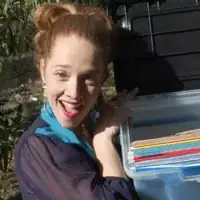 Ashley Moon, MAAshley Moon is the Founder and CEO of Creatively Neat, a virtual organizing and life coaching business based in Los Angeles, California. In addition to helping people organize their best life, she has a fabulous team of organizers ready to de-clutter your home or business. Ashley hosts workshops and speaking engagements at various venues and festivals. She has trained with Coach Approach and Heart Core for organizing and business coaching respectively. She has an MA in Human Development and Social Change from Pacific Oaks College.
Ashley Moon, MAAshley Moon is the Founder and CEO of Creatively Neat, a virtual organizing and life coaching business based in Los Angeles, California. In addition to helping people organize their best life, she has a fabulous team of organizers ready to de-clutter your home or business. Ashley hosts workshops and speaking engagements at various venues and festivals. She has trained with Coach Approach and Heart Core for organizing and business coaching respectively. She has an MA in Human Development and Social Change from Pacific Oaks College.
Professional Organizer The first thing I would do is figure out is what you actually want to keep. People just assume it's a good idea to keep everything, but if you've got a large number of books you should definitely consider downsizing. Once you've purged any unnecessary books, I'd use a large bookshelf for the vast majority of your books and then spread the remainder of the books out based on where you can keep them.
The first thing I would do is figure out is what you actually want to keep. People just assume it's a good idea to keep everything, but if you've got a large number of books you should definitely consider downsizing. Once you've purged any unnecessary books, I'd use a large bookshelf for the vast majority of your books and then spread the remainder of the books out based on where you can keep them. -
QuestionWhat can I do with books I don't need anymore?
 Ashley Moon, MAAshley Moon is the Founder and CEO of Creatively Neat, a virtual organizing and life coaching business based in Los Angeles, California. In addition to helping people organize their best life, she has a fabulous team of organizers ready to de-clutter your home or business. Ashley hosts workshops and speaking engagements at various venues and festivals. She has trained with Coach Approach and Heart Core for organizing and business coaching respectively. She has an MA in Human Development and Social Change from Pacific Oaks College.
Ashley Moon, MAAshley Moon is the Founder and CEO of Creatively Neat, a virtual organizing and life coaching business based in Los Angeles, California. In addition to helping people organize their best life, she has a fabulous team of organizers ready to de-clutter your home or business. Ashley hosts workshops and speaking engagements at various venues and festivals. She has trained with Coach Approach and Heart Core for organizing and business coaching respectively. She has an MA in Human Development and Social Change from Pacific Oaks College.
Professional Organizer Donate them! Charities and school districts could always use extra books. If you're not going to use them, pass them on to someone who will.
Donate them! Charities and school districts could always use extra books. If you're not going to use them, pass them on to someone who will. -
QuestionHow should I sort a large collection of books for long-term storage?
 Ashley Moon, MAAshley Moon is the Founder and CEO of Creatively Neat, a virtual organizing and life coaching business based in Los Angeles, California. In addition to helping people organize their best life, she has a fabulous team of organizers ready to de-clutter your home or business. Ashley hosts workshops and speaking engagements at various venues and festivals. She has trained with Coach Approach and Heart Core for organizing and business coaching respectively. She has an MA in Human Development and Social Change from Pacific Oaks College.
Ashley Moon, MAAshley Moon is the Founder and CEO of Creatively Neat, a virtual organizing and life coaching business based in Los Angeles, California. In addition to helping people organize their best life, she has a fabulous team of organizers ready to de-clutter your home or business. Ashley hosts workshops and speaking engagements at various venues and festivals. She has trained with Coach Approach and Heart Core for organizing and business coaching respectively. She has an MA in Human Development and Social Change from Pacific Oaks College.
Professional Organizer I'd probably sort them by genre. I'd put mystery books in one box, nonfiction in another, and so on. Label each box and you're done!
I'd probably sort them by genre. I'd put mystery books in one box, nonfiction in another, and so on. Label each box and you're done!
Things You’ll Need
- Oversized plastic storage bins
- Assorted storage containers
- Custom-built bookshelves
- Hanging storage bags
- Classroom easel with built-in storage
References
- ↑ https://www.simplykinder.com/organizing-your-classroom/
- ↑ https://www.prekinders.com/storage-organization/
- ↑ Ashley Moon, MA. Professional Organizer. Expert Interview. 30 August 2019.
- ↑ Ashley Moon, MA. Professional Organizer. Expert Interview. 30 August 2019.
- ↑ https://www.mother.ly/shop/12-minimalist-stylish-storage-solutions-for-all-your-kids-toys-books
- ↑ Ashley Moon, MA. Professional Organizer. Expert Interview. 30 August 2019.
- ↑ https://www.scholastic.com/teachers/blog-posts/alycia-zimmerman/4-classroom-organization-ideas-really-work/
- ↑ http://www.readingrockets.org/article/print-awareness-guidelines-instruction
- ↑ https://www.scholastic.com/parents/family-life/social-emotional-learning/social-skills-for-kids/12-ways-to-develop-your-childs-organizational-skills.html




